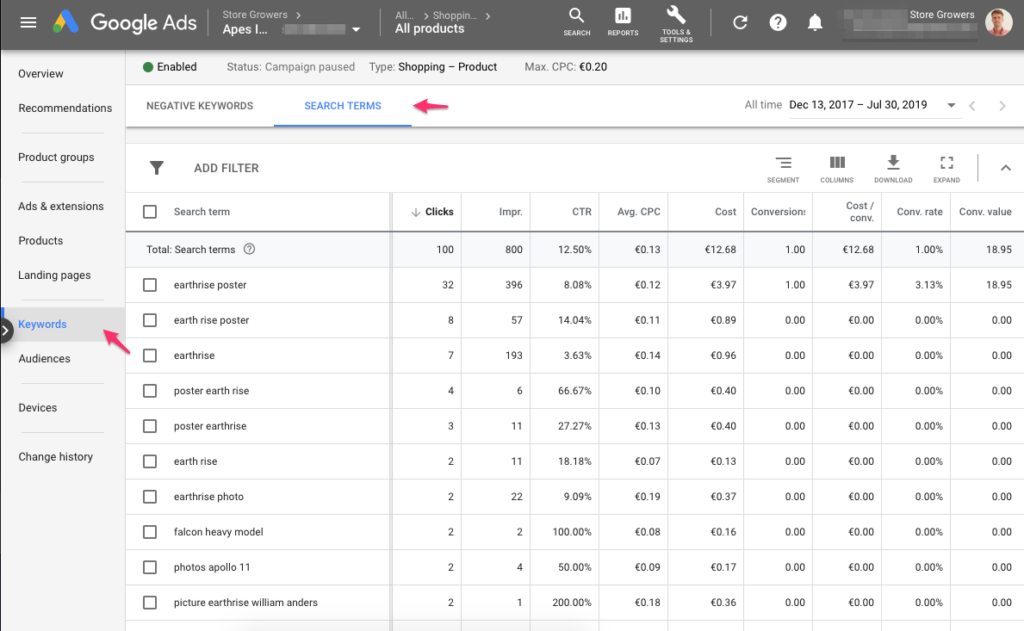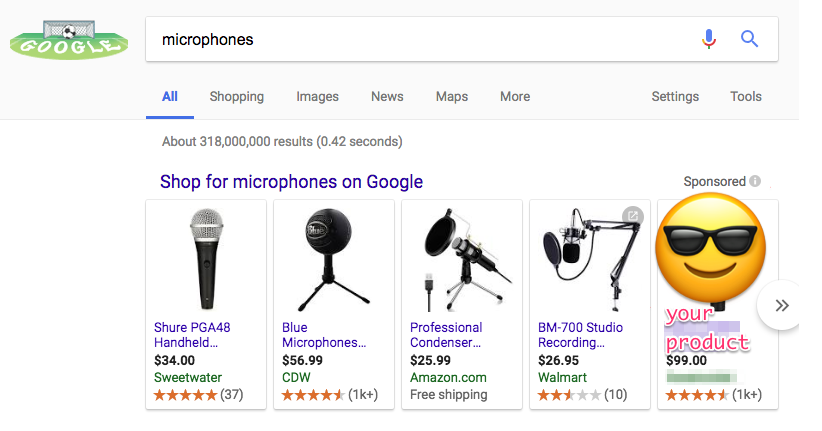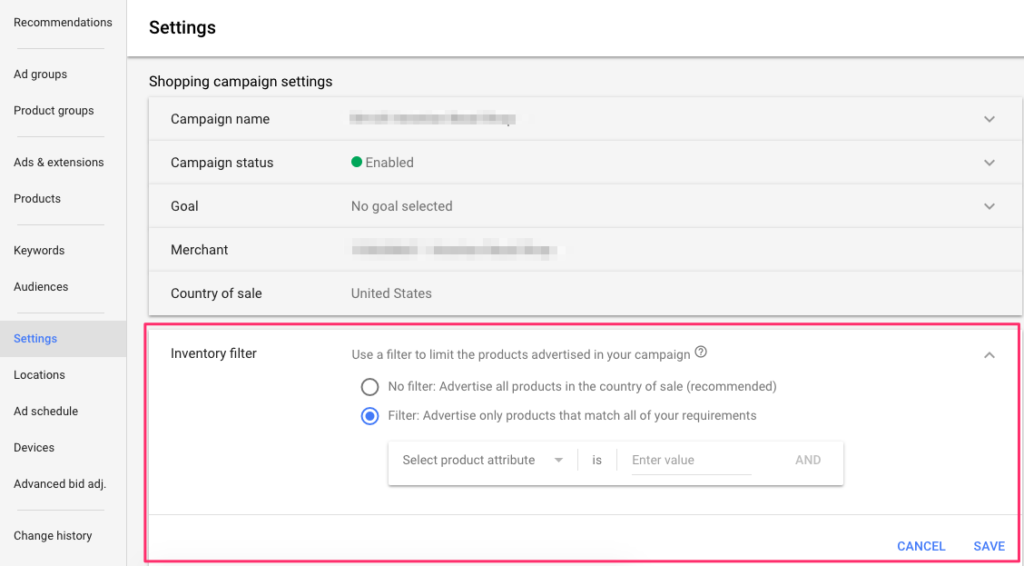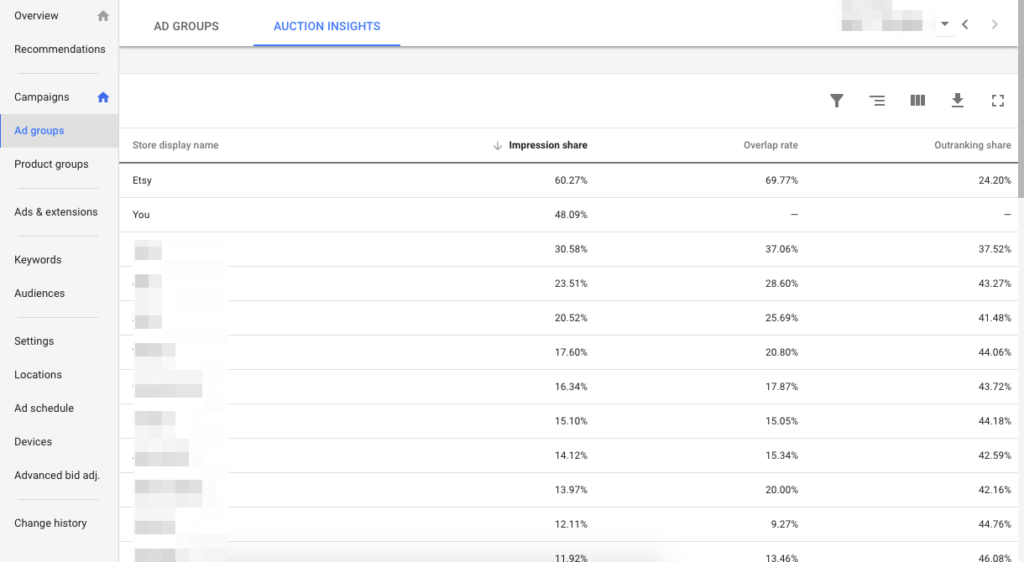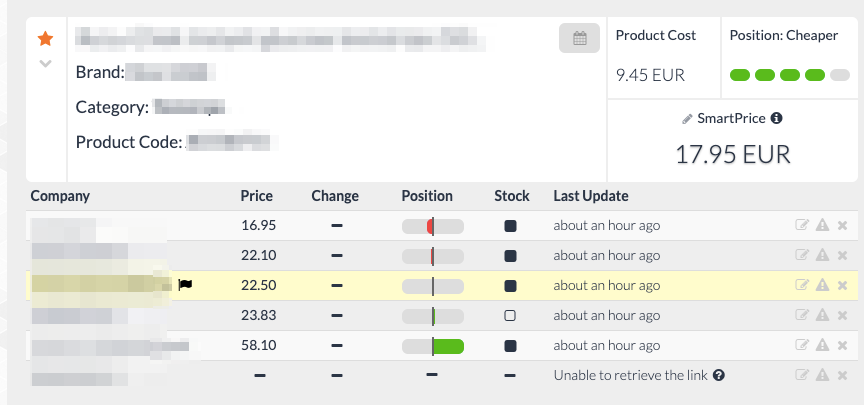Google Shopping optimization is a pretty fancy word to throw around. But what does it actually mean?
To me, it means taking action to get closer to your goals. These goals can be a certain revenue, profit, return or ad spend, or a number of clicks.
The exact tactics to achieve them depend on where you are in your optimization process.
In this article, I’ll show you the various levers you can pull in your campaigns to reach your goals.
All of these are tactics I’ve tested with my own campaigns or those of my clients.
The great thing about Shopping Ads is that Google does most of the heavy lifting for you.
You create a shopping feed, depending on whether you are using Standard Shopping or Performance Ma, this feed is automatically transformed into ads that match with relevant search queries.
But this ease of use also turns Shopping Ads into kind of a black box, and it’s unclear what else you can do to improve your results.
Google’s default recommendations aren’t surprising: increase the CPC and/or raise the budget.
But blindly raising the cost per click immediately cuts into your profitability.
So let’s explore some more effective things you can do!
We’ll start with basic optimization tactics and slowly make our way to the more advanced ones.
Note: We also have a dedicated guide on Performance Max optimization.
Table of Contents
1. Adding negative keywords
In Google Shopping you don’t need to add any keywords. But you have the option to add negative keywords to make sure you don’t show up for certain search queries.
First, let’s take a look at which search queries your ads are actually appearing for. You can find these in the Search Terms report:
This report shows you all the search queries that people have used for before they clicked on your product listing ad.
A) Irrelevant search queries
The lowest hanging fruit are the irrelevant search queries. These are searches that don’t have any value at all for your business.
These can be searches for products you don’t sell: children instead of adult sized clothes for examples. Or colors or variations of a product that you don’t stock.
These clicks are the equivalent of throwing money in the trash. So add them to your negative keywords to make sure you don’t pay for these searches anymore.
In our analysis of the Google Ads of Away Travel, we saw that their Shopping ads were showing for a couple of search terms that weren’t good matches:
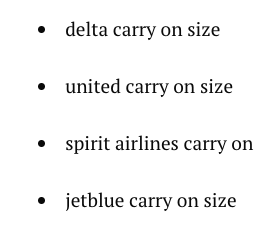
These are people looking up the allowed luggage dimensions for the airline they’re traveling on. These aren’t very likely to purchase a suitcase.
So this brand would be smart to look at the performance for their ads on these search terms and potentially exclude them from their campaigns.
Besides these irrelevant searches, you’ll find other search queries in this report that are not completely useless, but where it is more difficult to say if you should be paying for these clicks.
B) Competitor search queries
Competitor search queries are searches that include a competitors name together with an interesting keyword:
The above search terms report for one of my clients shows exactly this.
They sell consumer electronics and face fierce competition from players like Amazon, Walmart & Target. The report above shows the generic searches + amazon.
As it turns out, the searches that include Amazon aren’t completely worthless.
In the report, you can see ok click-through rates and even a sale. But in this case, it is a valid question to ask whether we should keep advertising on these searches. For this limited set of keywords, the total ad spend was $58.76 and revenue was $69.99. That’s not even close to breaking even.
In this case, we’ve excluded “amazon” for a couple of specific product categories where we couldn’t make it profitable.
Check in your own account if it makes sense to advertise on these competitor search queries. But if you’re hurting for profitability, you probably want to add these competitors as negative keywords.
C) Very generic search queries
Another group of queries you’ll see in the search terms report of your shopping campaigns are very generic search queries:
The search terms report above shows a couple of those very generic search queries. Look at the clickthrough rate of that first one: 0.02%!
It’s a keyword that’s not irrelevant, but it’s just one of the most generic descriptions of the category of one of the products that we’re selling.
Here is another example of that:
If you were selling a unique microphone with a specific use case, imagine being in the above line up. The chances that your product is exactly what the person is looking for are pretty slim. And even if they click through, they probably won’t buy.
Compare that to sites like Amazon, Walmart or Sweetwater. They just want to get their foot in the door, because they know that once people click over to their sites, they get a huge catalog of related products they can sell you.
Very low clickthrough rates will also reflect negatively on the quality score of your product ads, which is why you want to avoid these.
So if you’re in a competitive niche, you probably want to stay away from those short-tail keywords with huge search volumes. You can add them as negative exact matches to your search campaign.
This will be a lot of work at first because you’ll see a lot of similar keywords popping up. But just keep adding these high volume/low intent keywords and their volumes will drop.
While at first, it seems you can only exclude specific keywords from a campaign, in the next section I’ll show you how you can actually target specific search queries. Just like you do with Search campaigns.
2. Google Shopping campaign structure
Campaign structure deals with how you organize your different campaigns. How many do you have? Which products are included and where? How many ad groups do you have? Etc.
Campaign structure gets to the heart of effective Shopping campaigns. A good campaign structure enables you to bid on the products AND search queries that are most valuable to you.
In what follows, I’ll explore the 4 most common campaign structures.
Structure 1 – One undivided campaign
The first one is that there is a single campaign, with one ad group and one product group that contains all of your products.
This effectively means that every product and every search query is equally valuable to your business, as there is no one to distinguish between them.
This is far from ideal for your optimization efforts, all you can do is raise the max CPC for all products.
If you’re making enough money and can’t be bothered to invest more time to get better, you can leave it as it is. In all other cases, explore the other options below!
Structure 2 – One campaign with multiple products groups
The next logical step is to start breaking out different product groups based on some of your products’ attributes:
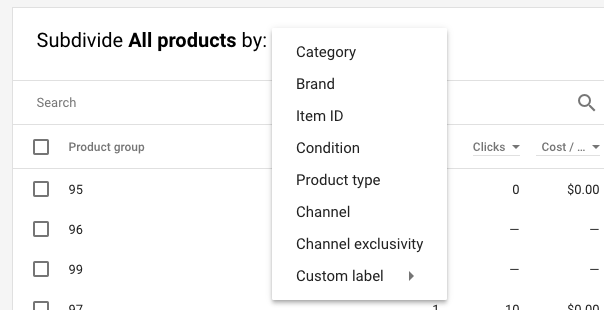
Google Shopping allows you to subdivide your product groups based on Category, Brand, Item ID, condition, product type, channel, channel exclusivity, or one of five custom labels.
You can also create multiple levels. For example, you first subdivide all your products based on product type, then you divide them by brand and on the third level by Item ID.
This campaign structure allows you to set bids based on the category, brand or individual product level Item ID).
This is the most common campaign that I see. It keeps things simple but allows pretty granular control.
If you’re not happy with the default attributes to subdivide your campaign on, you can use custom labels to add extra information into your feed.
With a lot of clients, I add price or margin information in these custom labels. That allows me to bid more aggressively for higher-priced, higher-margin products while keeping bids lower for the less profitable ones.
Structure 3 – Multiple campaigns with different products
Just like you split the product groups, you can also create a campaign based on the attributes we’ve discussed above.
To do that, you need to jump into the settings of your newly created campaign and use an Inventory Filter to only include part of your product offering.
This means you can have separate shopping campaigns based on a brand, product type, or category.
Another one I’ve often seen and used is using a custom label to create a campaign that only contains your bestsellers.
The biggest advantage of multiple campaigns is that you can set a specific budget for each campaign. That means that you can allocate 80% of your budget to your bestsellers, and 20% to your lesser products. If they’re all mixed into a single campaign it is harder to control this budget.
If you want to expand your campaigns to another country, you’ll also need to use a separate campaign.
Structure 4 – Multiple campaigns with the same products
Having multiple campaigns with the same products allows you to target a specific set of search queries with each one.
Yes, you CAN target search queries with Google Shopping campaigns. It’s also called search level query bidding.
The biggest advantage of this setup is that you can set different max CPCs based on how valuable a search query is to you.
The most common use case for this is to split branded search queries from generic search queries. You can bid aggressively on the branded search queries, while sharply reducing the max CPCs in your generic shopping campaign.
This is a great alternative approach to excluding them from your campaigns.
The example above is 2 campaigns for the same brand, one is a campaign that targets branded search queries, the other one targets generic queries.
Check the difference in CTR & CPC between the two. If you wanted to reach the same result with one campaign, the overall profitability would be a lot lower because your average CPC would be a lot higher.
Pro tip: If you use this campaign structure, be sure to get your campaign priority settings right. It’s an essential part of getting the keyword filtering to work correctly.
Here is an example of how beauty brand Glossier structures their Google Shopping campaigns:
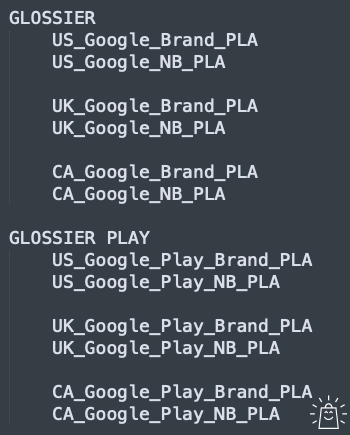
First, the company has split its campaigns depending on the brand: Glossier and Glossier Play (a sub-brand). Next, the campaigns are divided by country. One level deeper the campaigns are split into branded (B) and non branded (NB) queries.
3. Bid optimization for Shopping Ads
Once you’ve set up your Shopping campaigns and got your campaign structure right, most of the optimization work will be about getting your max CPCs to the right level.
High enough that you’re getting enough clicks, but not too high that you’re hurting your profitability.
This might sound simple, but it actually is pretty hard to do right.
So let’s start with an easier challenge 🙂
When to raise your campaign budget?
If your campaigns are profitable and Google indicates that you’re being limited by your budget or that you have a low impressions share, you can raise your budget.
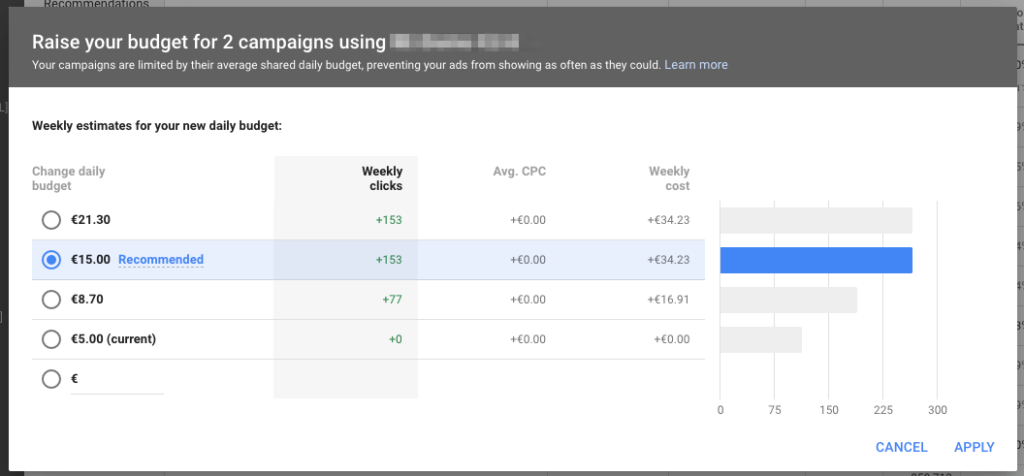
The Budget simulator will show you the budget Google Ads recommends, and its impact on your campaigns. In this case, they estimate that an extra €10 per day will get me 153 extra clicks.
Remember that these graphs are only a simulation. If you do raise your budget, keep a close eye on the results in the days and weeks after to make sure that you’re still making enough.
If you’re using an automated bidding strategy (I’ll explain what this means below), changing the overall budget will require Google to re-adjust to this new spending level.
But very often, Google won’t spend the budget that you’ve set. In that case, the only way to get more traffic is to raise the max CPCs.
When to raise max CPCs?
At first, you might need to raise your max CPCs just to get more traffic in the door.
You’ll need the data to be able to do all of the Google Shopping optimization described in this article.
The next moment to raise your CPCs is when you’ve got profitable sales coming in, and you’re looking to bring more of them.
That said, you will reach a ceiling for your max CPCs. And for some products, you might hit it pretty quickly.
I have a client that has a conversion rate of 7% in his online store. But we’ve maximized the traffic to his store, to increase beyond would mean we have to raise the CPCs to a level that would eat into the profits. So we’re stuck capped out at about 50% of all potential impressions.
If you run into this problem, you’ll get a few ideas on how to break through in the next sections.
How to set max CPCs?
This is the realm of bid strategy, the logic behind why you would increase or decrease the max CPCs for a specific product in a specific campaign.
It boils down to two basic choices:
- Do everything yourself. Set bids on the product level, dig through the reports, watch the metrics closely and adapt accordingly. It’s a lot of work, but the right move when you’re just starting out.
- Hand (some) of the controls to Google. This is done with Smart bidding strategies. The automated part means that Google decides how much to charge you for a click.
An important disclaimer here is that Google doesn’t care about your profitability. Their focus is on getting you to spend more. So blindly going into these automated bidding strategies might have bad results for your business.
In this section, we’ll explore how to find a balance in this tricky situation by going over the pros and cons of the different bidding strategies.
- Manual CPC
The manual option I described earlier is called “Manual CPC” meaning that you manually go through your product groups and adjust the CPCs based on what you see.
An example:
In one of your campaigns, you see that a specific product sells well, but it doesn’t get many clicks. If you increase the CPC by $0.1, you might get more clicks. Then a couple of days later you check if that increase had the desired effect.
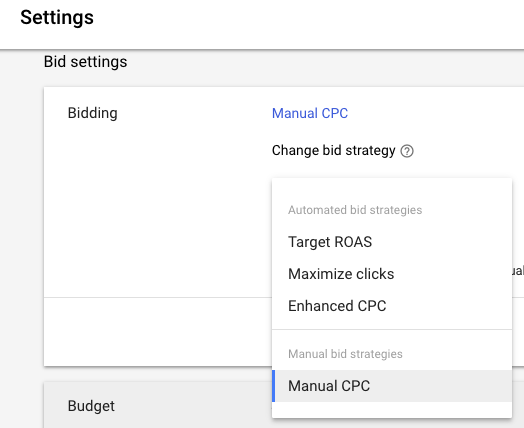
The other options described below are automated bidding strategies. Here you’ll leverage some of Google’s AI skills.
2. Maximize clicks
With the Maximize clicks bidding strategy, you’re giving Google the reigns. They will set CPCs in order to get the maximum possible clicks.
Google knows exactly which products/clicks are the cheapest, so that’s where they will shift your budget.
Since my goal is to sell more, I want the clicks to go to the products that have the highest likelihood of converting, not to search queries which happened to be a couple of cents cheaper.
You can use this strategy to get some data when you’re starting out. But I would stay away from it.
3. Enhanced Cost per click
The Enhanced cost per click or ECPC bidding strategy is very similar to Manual CPC, but Google has the freedom to raise the max CPC that you indicated if it thinks a specific click will result in a sale.
The technical details that Google provides are pretty vague, but they claim to use extra information about the likelihood that a user will convert to adjust your bid.

When optimizing for conversions, ECPC tries to keep your average cost-per-click (CPC) below the maximum CPC you set, including bid adjustments.
In Shopping campaigns, ECPC aims to increase conversions while keeping the overall spend the same.
With optimizing for conversion values, you can prioritize high-value conversions and assign different values to various conversion actions. This feature is available for Search and Shopping campaigns.
By optimizing for conversion value, ECPC helps you get more value for your ad budget.
4. Target ROAS
With the Target Return on ad spend or ROAS bid strategy, you’ll set a conversion value that you would like to achieve for every dollar/euro/yuan you put into your campaigns.

As shown in the screenshot above, a Target ROAS of 450% means that for every $1 I put into this campaign, I want to make $4.5 back.
Emphasis on want. Just because you want or need to make that return, doesn’t mean it will be possible.
Maybe for the above ROAS, I can only make 2 sales per month from this campaign.
While with a ROAS of 300%, I might be able to make 50 sales.
You don’t know beforehand, that’s why you need to be on Manual or Enhanced CPC for a while. Google Ads recommends at least 50 conversions in the last 30 days before you activate this strategy.
That also allows you to establish a baseline to compare the results of the automation.
This is an automated bidding strategy, so Google Ads will need time to get it going and process any changes you make to the campaigns.
If you get this working, your job just becames a lot easier.
This doesn’t mean you should run this campaign on auto-pilot. Automation changes, promotions or new competitors can cause big changes.
So be sure to monitor these campaigns and put the necessary alerts in place.
Pro tip: To do the above, there are a ton of optimization software tools on the market that can help with this. A lot of them use techniques like AI & machine learning to improve your results.
They make big claims, often are expensive and I have yet to see them provide adequate ROI. So, don’t believe any promises and test it out for yourself.
4. Competitive intelligence in Google Shopping
All of the work described above (and below) can really help your campaigns.
But your campaigns don’t exist in a vacuum. Things that your competitors do or don’t will have an impact on your results.
Seeing how you stack up and what they do better can give you more ideas to improve your own campaigns.
So in this section, I’ll show you what information is out there, and what to pay attention to.
Google Shopping performance by vertical
If you’re new to Google Shopping (or even advertising in general), these Shopping benchmarks below can give you an idea of what competitors are doing.
| Vertical | AOV | CTR | CVR | ROAS |
| Apparel/Accessories | $88 | 1.30% | 2.28% | 4.27 |
| Automotive | $222 | 1.55% | 0.99% | 8.34 |
| Comp/Electronics | $197 | 0.73% | 1.72% | 10.13 |
| Food/Drug | $52 | 1.32% | 2.61% | 4.77 |
| Health/Beauty | $61 | 1.03% | 10% | 3.53 |
| House/Home | $205 | 1.03% | 2.87% | 6.79 |
| Jewelry | $200 | 0.90% | 0.75% | 2.97 |
| Mass Merchant | $58 | 1.31% | 4.65% | 4.14 |
| Office Supplies | $104 | 0.87% | 3.23% | 3.60 |
| Pet Care | $21 | 1.34% | 3.81% | 1.25 |
| Sporting Goods | $112 | 1.29% | 2.71% | 6.07 |
| Toys/Hobbies | $79 | 1.42% | 2.81% | 10.25 |
You can check our Google Shopping benchmarks here.
Will your numbers look exactly the same?
Probably not. But knowing if you’re in the same ballpark can indicate more fundamental problems with your merchandise or website.
Search impression share metrics
The Search impression share is the percentage of search results that your product listing ads appeared in compared to all the potential search results they could have appeared in.
A 100% search impression share (IS) means your advertisements appeared every time someone searched for a relevant keyword.
The two reasons why your ad might not show every time someone searches for your product are insufficient budget & low ad rank.
To see this in your Google Ads account, go to the Campaigns tab, select the Columns icon, click Modify columns, Competitive metrics and add Search Impr. share, Search Abs top IS , Search Lost IS (rank), and Click share, then click Save.
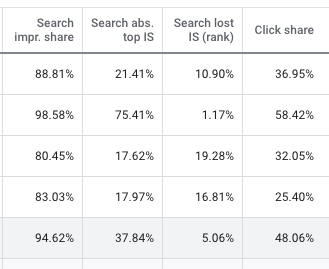
Let’s break down all of these columns and discuss what you can learn from the numbers in the above screenshot.
- Search Impression Share
As I mentioned above, this one is the key metric. It indicates what percentage of searches you are appearing for. It depends on your approach what number you want to hit.
With a search impression share of 100% your ads show up for every related search, but maybe that’s not really profitable.
The great thing about splitting your campaigns based on the type of search query is that you can control the impression shares of these different campaigns.
You could, for example, maximize the impression share of the branded queries while keeping the IS of the generic campaign at 25% because it’s not profitable.
2. Search Absolute Top Impression Share
Absolute top impression share (Search Abs top IS in Google Ads) shows you the percentage of searches that took the top slot of all the products listing ads. That’s the product highlighted in pink below:

Google decides the order of the products depending on price, reviews, relevance, etc. That top slot is often reserved for a well priced best seller.
It doesn’t make sense to try and be there for every product, but in some cases it is interesting.
3. Search Lost IS (rank)
The Search lost IS shows the number of impressions you miss out because of low ad rank. That can be because your CPC is too low, or a case of your quality score being too low.
To explain why this is happening, you need to know a little bit about the Google Ads auction system.
For every single search that happens on Google, they identify which advertisers want to appear and what advertisements they want to show (which image, title, description, landing page, etc.). From all this data Google calculates a Quality Score.
If your Lost impression share (rank) is high, you have a couple of options when this happens:
- Improve your ad rank by raising your bid
- Refine search queries that your product listing ads appear for, this will improve your CTR which could raise your quality score
- Improve the data quality of the product feed you submit to Google (more about this further down the article)
This is where the biggest potential is for most campaigns, but it is also the hardest part to get right. This is because you can’t directly influence this Quality Score.
4. Click share
The last of the search IS metrics you can find in Google Ads is Click share. This is the percentage of clicks that your ad got when it was shown.
You can use click share to spot searches where a high impression share isn’t translating into more traffic. This might indicate that your ad is less relevant for that search query, or might indicate a pricing difference.
Auction Insights
The competitive metrics described above give you information on how your account or campaigns are doing, the Auction Insights report shows you how you stack up against your Google Ads competitors.
This report, available on the account, campaign and ad group level will show you which other advertisers are advertising on the same keywords then you are.
I’ve already covered the Impression share above, so let’s look at what other interesting things you can take away from this report.
For this specific campaign, you can see that Etsy takes the majority of the Impressions. Etsy is advertising in about 70% of the impressions where this advertiser’s ad is showing (= Overlap rate). This advertiser is ranking higher than Etsy’s ads in 24% of the cases where both ads show (= Outranking share)
Be sure to look at this report for different time frames, it allows you to monitor the evolution of your competition or the impact of your optimization work.
If you see a lot of big players in the report like Amazon, Etsy, Walmart, Target, you know it’s going to be hard to match them budget-wise. So instead of blindly raising your budget & CPC and hoping to out-do them, you can try to figure out which product categories or brands they are spending hard on.
Do this by running this Auction Insights report for different campaigns or ad groups.
Benchmark CTR & CPC
The Impression share metrics and Auction Insights report will tell you what is happening and who is doing it, not why it’s happening.
That’s something that the benchmark metrics will tell you.
Benchmark CTR, Benchmark Max. CPC, and Benchmark product price difference tell you “how other advertisers’ Product Shopping ads are performing for similar products”. (definition from Google)
You can add these as extra columns in the Product Groups overview:
In the screenshot above I’ve also added the Avg product price column from the Shopping section.
The first caveat is that Google always wants you to spend more, so these metrics would be perfect to push you to do so. So use them as indicators, not targets or goals.
Let’s look at two brand product groups in the example above:
Brand 1:
The max CPC in this product group is €0.33, a bit below the Benchmark max CPC of €0.37. The CTR of 5.02% is more than double the Benchmark CTR. That means the products are doing pretty well.
The Benchmark product price difference indicates that we’re slightly more expensive than other products. From a ROAS point of view, it’s also far exceeding our goals, so perhaps we could even raise the max CPC higher to capture more impression share.
Brand 2:
The max CPC here is €0.3, well below the Benchmark max CPC of €0.52. The CTR of 3.83% is also well above the Benchmark CTR of 1.59%.
The Benchmark product price difference shows that we’re slightly cheaper vs competitors selling the same products. These three metrics indicate that if we increase the spend, we could probably capture more impression share in a profitable manner.
These metrics are available for each product group. So if you are only using a single product group, consider subdividing it to get a better idea of the performance of each product.
6. Shopping Feed Optimization
If you’ve done all of the above, your Google Shopping campaigns should be in good shape. But even then, you might not be able to hit the numbers you need.
So in this section, I’ll tackle the last piece of Google Shopping optimization: your product feed.
Before you implement any of the things below, all of the errors and warnings in Google Merchant Center should be fixed. Especially around product identifiers.
The next step is about improving the data in your feed to increase your visibility and competitiveness.
Product title optimization
Product title optimization is all about making sure that you’re showing up for the more relevant search queries.
Having a good title can really improve the visibility and CTR of your products.
Besides merely adding them, it’s also important to keep the structure of your title in mind.
Here is a search for “best fish oil pills”:
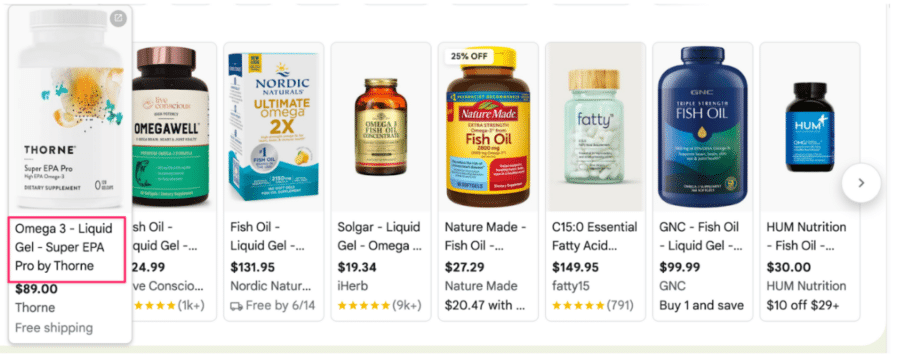
The first product listing ads doesn’t mention the word fish oil at all. They do mention Omega 3 (which is the active ingredient in fish oil). That could have an impact on its CTR for these searches.
The lesson here is to pay attention to the product title cutoff. The exact character limit is always shifting but try to keep it as short as possible.
To get more in-depth insights on how to improve your own product titles, check our original research on the topic!
Or watch this video below:
Competitive prices
A lower price improves the quality of your product feed for your customer (it’s a better offer) and for Google (people will click your ad more often).
But of course, there is a clear limit on how low you can and should go. Often prices are already as low as you can go.
As described above, low click shares or low click-through rates can indicate that your offer (which includes your price) is less attractive than that of competitors.
That’s why keeping an eye on the pricing strategies of your competitors can be really helpful.
Here a screenshot from a tool called Prisync. It shows how this retailer ( in yellow) stacks up against its competitors:
In this case, the retailer sells the product for €22.50, while other retailers sell the same product for €16.95. That’s a pretty big gap and will have repercussions for Google Shopping.
The ad with a product price of €16.95 will have a much higher CTR which leads Google to show it more often. Because of the lower price, the conversion rate for that product will also be higher.
This is information that is partially visible with the product price benchmarks mentioned above, but looking at it a bit deeper for your top products is well worth the time.
But it’s not just the product price that matters, it’s the full price, including shipping costs.
Some retailers are sneaky and will leave out shipping or “handling” costs from their product feed and merchant center. This will make their prices a lot lower and get them more visibility and clicks in the Shopping results. Sometimes they get away with it, other times not.
If you see a competitor not communicating shipping costs (and stealing clicks from your ads, here is where to complain to Google:
That link is located at the bottom of the Shopping tab of the search results.
Product image optimization
Getting new product images is expensive, so before investing you need to be sure that it will be worth it.
In Shopping, product images need to be simple and clear.
But if everyone is doing the same, all ads look the same. If you have different images available, consider adding a different style:
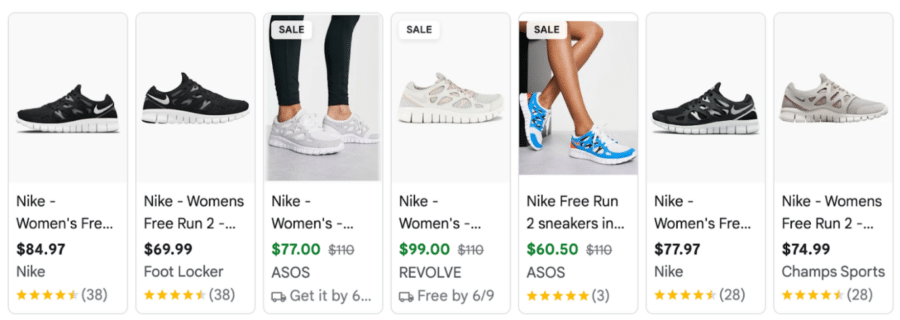
Having the shoe at an angle, Kohl’s ad stands out a little. These are little tricks that don’t require a new shoot, but you might need some Photoshop tweaks.
Improve product descriptions
This one comes up a lot in google shopping optimization lists. But it’s not clear if this has a big impact on the actual Shopping Ads.
From my own experience, if you have solid SEO optimized product descriptions, they will help you for keywords that might not be included in the product title.
So can double-check your Search Terms report to make sure you have the top keywords in there.
Note: the product description isn’t visible in the actual ads, it does show with the Free Listings.
6. Comparison Shopping Service (CSS) providers – EU only
If you’re selling within the European Union, you can get a 20% discount on your cost per click.
That’s a direct result from the $4 billion fine that the EU gave Google for unfair competition in the Shopping Ads. To rectify the situation, Google had to allow other comparison shopping providers in its ad carousel.
Here is what that looks like:
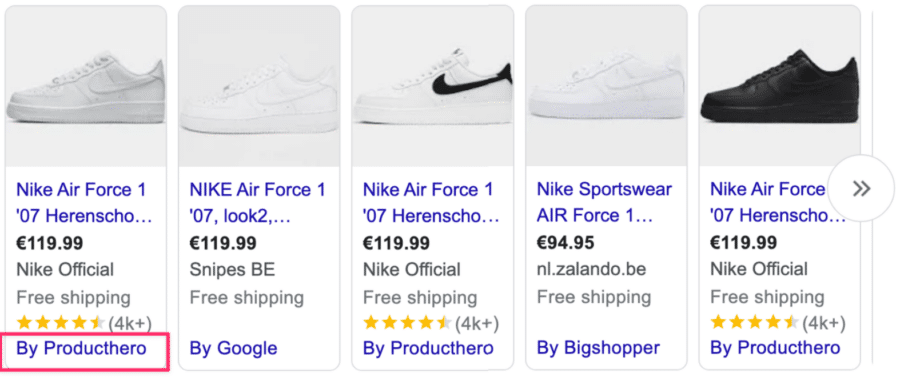
For that to work financially, Google skips its 20% service fee it usually charges for advertisers that use their system.
CSS providers could in theory pocket that 20%, but no one would switch. So instead most of them charge a flat monthly fee (€20-50) and pass the 20% CPC savings straight to the advertisers. These providers often have a marketplace where they take affiliate commissions.
Switching over from Google to a CSS provider is pretty simple. You need to make a switch in Google Merchant Center so the new provider can access your product feed.
Comparison Shopping Service providers are different depending on the geography/language. Check Google’s database for one that seems suitable to you.
Next steps
Working your way through all of the optimization tactics described in this article will bring you amongst the top advertisers on Google Shopping. That doesn’t mean that the work is done.
To remain competitive, constant tweaks are needed, especially when it comes to bidding and monitoring your competition.
Google continues to make changes to the Google Shopping platform. So staying on top of new features or possibilities can help you get an edge over competitors that neglect this part.
My premium training course
If you like this article but want to dive into even more detail on Google Shopping optimization? Check out my Google Ads course. In this online video course, you’ll go from scratch to having the first sales come in via your Shopping campaigns.
The feedback so far has been really great so I encourage you to check it out!

